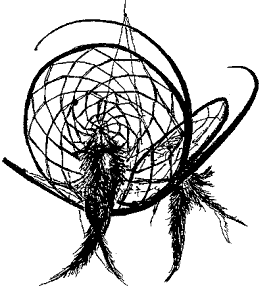Modern Era
The interest in the fate of the Ten Lost
Tribes received a new impetus from a number of developments, among them the
growth of the Kabbalah and of the Jewish mysticism after the 16th
century, including various messianic movements, of them that of Shabbetai
Zvi (1626-1676) having the strongest impact. The great geographical
discoveries and the European contact with previously unknown regions and
populations also contributed to an increased interest in the quest for the
Ten Lost Tribes of Israel. The Jerusalem kabbalist R. Abraham ben Eliezer
ha-Levi in a letter from 1528 describes the Jews of Ethiopia as descendants
from the tribes of Dan and Gad while in a letter to R. Israel Ashkenazi of
Jerusalem there is mention of a man claiming to belong to the Ten Lost
Tribes and who testified that the Ten Lost Tribes do not have any knowledge
of the Oral Law. David Reubeni, a 16th century Jewish adventurer,
managed to be received by Emperor Charles V in Regensburg along with the
false messiah Solomon Molcho (1500-1532), and claimed to represent a
relative of King Joseph who ruled over the tribes of Reuben, Gad and half
Manasseh. David Reubeni eventually died in a Spanish prison in 1538, but his
extraordinary story prompted Abraham ben Mordechai Farissol (c.1451-c.1525),
the first Jewish author to mention the newly discovered American continent,
to dedicate an entire chapter of his tractate to the subject of the Ten Lost
Tribes – (Igeret Orhot Olam, Venice, 1586). In the 17th
century, the myth of the Ten Lost Tribes became a central theme of Sabbatean
propaganda – Shabbetai Zvi; the false messiah is depicted as commander of
the Ten Tribes. At the same period, R. Manasseh ben Israel of Amsterdam
(1604-1657) in his book Mikve Israel (Hope of Israel, London,
1652) brings the testimony of the Portuguese crypto-Jew, Aaron Levi (known
as Antonio de Montezinos), who claimed to have encountered during his
travels to South America (Ecuador, Peru, Colombia, Venezuela) Indian tribes
practicing some Jewish rituals and who allegedly were descendants of the
tribes of Reuben and Levi. Manasseh ben Israel used the legend of the lost
tribes in pleading successfully for the admission of Jews into England
during Oliver Cromwell's regime.
The 19th century saw a renewed
interest into the fate of the Ten Lost Tribes by Jews. Some Jewish
communities sent emissaries to search for the Ten Lost Tribes; other seekers
were private individuals who undertook to disclose the place of the Ten Lost
Tribes. Of them a special mention should be made of Joseph Israel
(1818-1864), a Romanian-born Jewish adventurer and great admirer of Benjamin
of Tudela to the extent that he changed his name to Benjamin the Second.
Joseph Israel traveled between 1845 to 1859, from Istanbul, Turkey, to
Egypt, Syria, Land of Israel, Kurdistan, Mesopotamia, Persia, Afghanistan,
India, and after 1859 to North America, searching and inquiring everywhere
for the Ten Lost Tribes. Joseph Israel met various Jewish communities and
collected valuable information about their way of life and traditions. Among
the Jewish communities of Asia, he met of the
Bene Israel in India who in Israel's opinion were descendants of of the
Ten Tribes.
Jewish travelers from the Land of Israel that
set out in search of the Ten Lost Tribes in the 19th century
include Rabbi Baruch of Pinsk, who was murdered in Yemen having left Safed
in 1830; Isaac son of Chaim Baruch Halevi (d. 1886) who traveled from
Tiberias to India hoping to find the Sambatyon river; Ezekiel Asche, a
German-born physician who left Jerusalem in 1848 and disappeared in
Ethiopia, having traveled through Egypt and Yemen; and Rabbi Moshe Yaffe of
Hebron who disappeared during his second visit to India in 1848.
Moses ben Isaac Edrehi (1774-c.1842), a
Moroccan-born rabbi and kabbalist who lived for many years in Amsterdam and
London and eventually immigrated to the Land of Israel is the author of two
works dealing with the quest for the Ten Lost Tribes. Ma'aseh Nissim
(originally published in Hebrew and German in Amsterdam in 1809), is a
mythical description of the Sambatyon river who was later published in
London in 1834, along with An historical account of the ten tribes,
settled beyond the river Sambatyon in teh Eastl with many other curious
matters relating to the state of the Israelites in various parts of the
world, published in London in 1836.
The quest for the Ten Lost Tribes of Israel
has been conducted by Jews, Christians and Muslims, in practically every
corner of the earth. As a matter of fact during the last centuries this
search turned into a theme that has reoccurred occasionally with many
Christian travelers, missionaries, authors, and explorers belonging to the
Roman Catholic Church as well as to various Protestant denominations. Jewish
motifs and beliefs were adopted by non-Jews while Jews accepted some
concepts and ideas developed by non-Jewish seekers of the Ten Lost Tribes of
Israel.
At various periods, indigenous tribes and
peoples over all continents were identified as possible descendants of the
Ten Lost Tribes. The supposed offspring of the Ten Lost Tribes have included
different ethnic groups living in Asia - Afghanistan, Azerbaijan, Burma
(Myanmar), Kurdistan, Kashmir, China, Japan; in various countries and
regions of West Africa – Mali, Ghana, Nigeria; in Southern Africa –
Zimbabwe, Lesotho, South Africa, Mozambique, in East Africa - Uganda,
Ethiopia, Eritrea; in Europe - the Celts of the British Isles; in Oceania -
the native people of New Zealand; in South America - Ecuador, Colombia,
Venezuela; and in North America, where various native American nations as
well as the Mormons were linked to the Ten Lost Tribes. Occasionally,
beliefs disseminated by European travellers, Jews and Christians alike, were
eventually adopted by some of the indigenous ethnic groups and sometimes,
after being further elaborated by them, evolved into an integral part of
their ethos and identity.
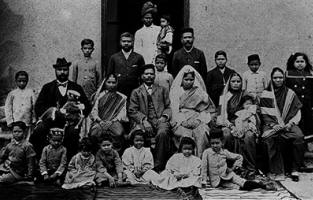 |
Bene Israel family in Bombay
Bombay, India, c.1890
Photo: Carmel Berkson, India
Beth Hatefutsoth – Visual Documentation Center
Carmel Berkson Collection, India
|
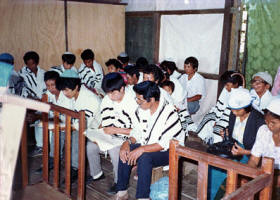 |
Prayer at the Zion Shalom Synagogue in Aizawl
Mizoram, India, 1989
Photo: Samuel Joram
Beth Hatefutsoth – Visual Documentation Center
Courtesy of Myer Samra, Australia
|
The Quest for the Ten
Lost Tribes of Israel
The New World
The discovery of the American continent with
its various populations generated among the Jews and the Christians alike a
number of speculations about the supposed Israelite origin of the American
Indians. The Spanish bishop Bartolomeo de Las Casas
(1484-1566), a fervent defender of the rights of the native nations
of the Americas, forwarded a theory according to which the American Indians
were descendants from the Ten Lost Tribes of Israel. The same idea was
advanced by some English missionaries. Thomas Thorowgood is his book
Jewes in America, or Probabilities that the Americans are of the Race
(London, 1650) strongly supported the idea of relating the American Indians
to the ancient Israelites. Although Thorowgood's theory was disputed soon
after its publication, among others by members of the clergy, it
nevertheless did not loss its attractiveness for other seekers of the Ten
Lost Tribes of Israel who continued to raise new ideas and speculations in
support of the Israelite origin of all or part of Native American nations in
both the Northern and Southern American continents.
Myth of the Lost Ten Tribes of Israel
1
-
2 -
3
-
4
White Eagle Soaring: Dream Dancer of the 7th Fire


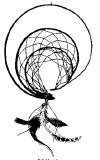
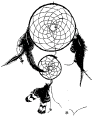
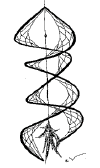


 Get
a course to promote your business online, explode your sales
Get
a course to promote your business online, explode your sales Get
software to promote your business online in less time
Get
software to promote your business online in less time Get
software to streamline your business and run it hands free.
Get
software to streamline your business and run it hands free.